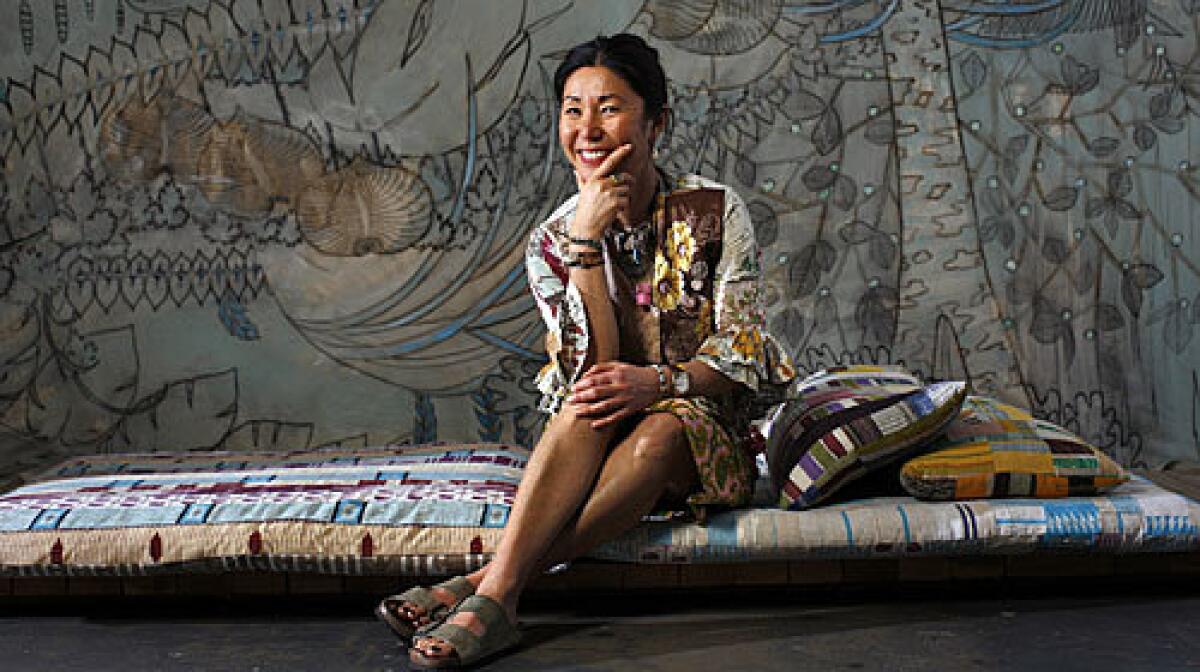Dosa’s Christina Kim: Every piece is precious

In the course of developing her eco- and human-friendly couture, L.A.-based designer Christina Kim has braved riots in Nepal, violent religious clashes in India and a nasty, brutish standoff between striking teachers and the state governor in Oaxaca, Mexico.
Other designers might regard such encounters merely as a necessary cost of doing business in the increasingly globalized high-fashion world. But Kim, who was born in South Korea and moved with her family to Los Angeles in 1971 when she was 15, sees her risk-taking odysseys as part of a deeper commitment to treating people, as well as the planet, with empathy and respect.
“It’s not just thinking about the natural resources, but the human resources,” says Kim, whose fair-labor practices and preference for long-lasting garments made with recycled scraps and natural dyes over trendy, throwaway apparel treated with harmful chemicals have placed her in demand not only as a designer but also as a thinker. Time magazine named her one of its innovators of the year in 2003, and this year she was a panelist on a UCLA Hammer program titled “Conscientious Consumption: The Future of Luxury in an Age of Sustainability.”
Many of Kim’s fashion creations for Dosa, her company, incorporate recycled materials, gleaned from a variety of countries and cultural traditions. But Kim isn’t simply racking up frequent-flier miles doing Third World scavenger hunts. She works with nongovernmental organizations and keeps her markups low, while attracting such A-list admirers as Nicole Kidman.
Her extensive research into her subjects (often with scholars and textile experts) generates ongoing partnerships that typically last a minimum of three years, not just one fashion season. Frequently, Kim employs local artisans and craftspeople — jamdani (fine cotton muslin) cloth weavers in Ahmedabad, India, for example, or Oaxacan fine-art paper makers in Mexico -- whom she pays two or three times the local labor rate.
Kim believes that supporting these artisans, and having regular contact with them in good times and bad, builds long-term, trusting relationships. It also fits within her broader philosophy of encouraging people to consume less but cherish more the things they buy and wear, including the sweat equity and consummate craftsmanship of the people who made them.
For Kim, that means appreciating not only the textures, colors, shapes and patterns of materials but also their histories and identities, the multiple lives they may have led while traveling from a Yoruba cloth market in West Africa, say, or an Indian women’s sewing cooperative, to Kim’s downtown L.A. retail showroom.
“That’s probably the biggest thing you give,” she says of her relationships with far-flung collaborators, “that you’re not just looking at them as tools, you’re looking at them on a human level.”
Kim’s humanistic calculus derives as much from her personal immigrant experience as from her political and spiritual values. Growing up in postwar South Korea, she learned to make a virtue of scarcity by reinventing hand-me-down clothing and finding new uses for old U.S. Army surplus sweaters and the like. Later, at John H. Francis Polytechnic High in the San Fernando Valley, she and her friends would get together to sew their own prom dresses.
Kim believes that when garments, housewares and other items pass through multiple pairs of hands during their construction, they undergo a “transfer of energy.” She regards clothing imperfections not as “flaws” but as personality markers, as distinctive as a mole or a beauty mark.
Similarly, she considers the discipline imposed by working with finite resources to be not an impediment but a spur to imagination and inventiveness. Recycling limits you to “essences,” she says. “To me, it’s like a symphony. The orchestration does get pretty intense.”
To illustrate, Kim pulls a jacket off the rack at her studio-factory that’s from a collection inspired by Chinese musical instruments made of lacquer. Its cuff was assembled from fabrics left over from three previous collections. The lining, made of brilliant scraps with gold predominating, has the polychrome sensuality of Klimt’s kissing lovers. “Because it’s my eye, I could put it together so it still makes sense,” Kim says of her quilt-like montages. “It’s still like it’s all one song.”
That song, for Kim, ultimately is a freedom chorus about the dignity and capacity for self-invention of every individual. She eschews trade shows and doesn’t do runways, because she views them as “really the beginning of the branding,” and why, she reasons, would anyone want to slap a label on herself?
“Freedom was not easy in Korea: war, liberation, women being second-class,” she says. “As I designer, I want to give them a palette, and then they can paint whatever they want.”







